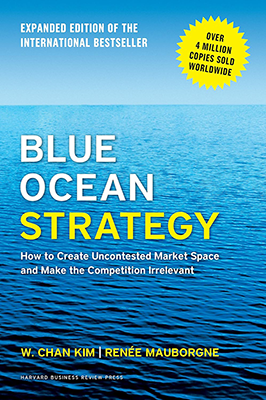Blue Ocean Strategy
“Blue Ocean Strategy” by W. Chan Kim and Renée Mauborgne is a groundbreaking business strategy book that presents a framework for creating uncontested market space and making competition irrelevant. Here’s a summary:
Red Ocean vs. Blue Ocean: The authors introduce the concept of “red oceans” and “blue oceans” to describe different market environments. Red oceans represent existing industries where competition is fierce, and companies compete for the same customers. Blue oceans, on the other hand, represent untapped market space with little to no competition.
Value Innovation: The key to creating a blue ocean is value innovation, which involves simultaneously pursuing differentiation and low cost. Instead of choosing between differentiation or cost leadership, companies can create new market space by offering unique value at a lower cost.
The Six Principles of Blue Ocean Strategy:
– Reconstruct Market Boundaries: Instead of focusing on existing market boundaries, companies should look to create new market space by redefining industry boundaries.
– Focus on the Big Picture: Blue ocean strategy requires a focus on the big picture rather than getting bogged down in small details. Companies should look at the overall market landscape and identify areas of opportunity.
– Reach Beyond Existing Demand: Successful blue ocean strategies often involve creating new demand rather than competing for existing demand.
– Get the Strategic Sequence Right: Companies should sequence their strategic moves in the right order to maximize impact and minimize risk.
– Overcome Key Organizational Hurdles: Implementing a blue ocean strategy often requires overcoming organizational hurdles such as internal resistance and inertia.
– Build Execution into Strategy: Execution is as important as strategy in implementing a blue ocean strategy. Companies need to ensure that their organizational structure, processes, and systems support their strategic objectives.
Tools and Frameworks: The book provides various tools and frameworks to help companies identify and implement blue ocean strategies, including the strategy canvas, the four actions framework, and the buyer utility map.
Examples of Blue Ocean Strategy: The authors provide numerous examples of companies that have successfully implemented blue ocean strategies, such as Cirque du Soleil, Southwest Airlines, and Nintendo Wii. These companies have created new market space and achieved significant success by offering unique value propositions to customers.
Overall, “Blue Ocean Strategy” offers a comprehensive framework for creating uncontested market space and making competition irrelevant. It challenges conventional wisdom and provides practical guidance for companies looking to achieve sustainable growth and profitability.

